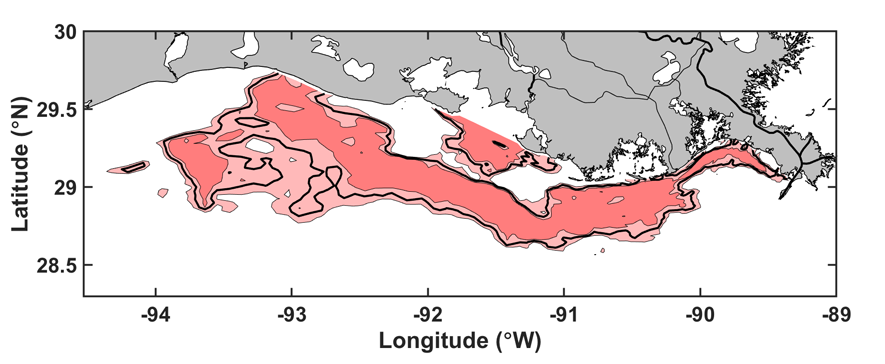

Gasping for breath: low oxygen “dead zone” in Gulf of Mexico will be three times as large as Prince Edward Island, forecast finds
(HALIFAX, N.S.) Thursday, June 7, 2018 – Dalhousie University scientists forecast that the northern part of the Gulf of Mexico will experience a hypoxic zone, or an area of low oxygen also known as a dead-zone, about three times the size of Prince Edward Island this summer. The Dalhousie forecast has been released simultaneously with the annual dead-zone forecasts from the National Oceanic and Atmospheric Administration (NOAA) and the United States Geological Survey (USGS).
“The hypoxic zone in the Gulf of Mexico forms every summer and is the largest in North American coastal waters. Freshwater and plant nutrients—mostly from unused agricultural fertilizer, and urban and industrial wastewater—travel to the Gulf from the Mississippi River,” says Katja Fennel, an oceanographer at Dalhousie University. “These nutrients stimulate a sequence of biological transformations in coastal waters that significantly decrease oxygen levels near the bottom resulting in an environment unable to support most higher marine life forms.”
All forecasts of the hypoxic zone in the northern Gulf of Mexico are based on an estimate of spring nutrient discharge from the Mississippi, determined by the USGS every May. The simulation model developed by Dalhousie researchers Katja Fennel and Arnaud Laurent provides a comprehensive way for scientists to simulate the hypoxic zone’s location, size and evolution through the summer season. This level of detail has never before been achieved in hypoxia forecasts.
Dalhousie’s simulation indicates that the hypoxic zone in the Gulf of Mexico will reach a maximum size of 17,900 km2 in late July. It forecasts the mean size between July 23 and 29, when a monitoring cruise will map location and extent of the hypoxic zone, to be slightly smaller at 15,900 km2. This is about three times the size of Prince Edward Island, and bigger than the 33-year average Gulf hypoxic zone of 14,000 km2.
The National Oceanic and Atmospheric Administration (NOAA) and the United States Geological Survey (USGS) forecast a size of 15,000 km2 for late July, which is the average of an ensemble of four statistical models.
“Our more detailed model also is used for scenario simulations to investigate the effects of potential nutrient reductions in the watershed and of climate change on the hypoxic zone,” explains Arnaud Laurent, one of the model creators. “We find that significant nutrient reductions will be necessary to decrease the hypoxic zone. This becomes even more important because future warming will lead to more severe hypoxic conditions.”
Many other coastal regions around the globe also are experiencing declines in oxygen, leaving marine animals increasingly gasping for breath. In the Canadian Maritimes, the Gulf of St. Lawrence and the Scotian Shelf are suffering from low-oxygen in near-bottom waters, squeezing the habitat of several commercially important and endangered fish species. This trend has been ongoing for several decades, as man-made inputs of nutrients and global warming conspire to depress oxygen levels in coastal ocean waters.
-30-
Media Contact
Niecole Comeau
Faculty of Science Communications Officer
Dalhousie University
m. 902.223.2446
o. 902.494.8443
Niecole.comeau@dal.ca
Additional Information

Figure 1: Predicted hypoxic zone in the northern Gulf of Mexico in late July 2018 shown in red. The thick black line outlines the predicted mean. Light red shading indicates where the prediction is uncertain.

Figure 2: Temporal evolution of the predicted hypoxic zone in 2018 shown by the black line. Grey shading indicates the uncertainty.
Related Materials
Laurent, A., Fennel, K., Ko, D.S., Lehrter J., Climate change projected to exacerbate impacts of coastal eutrophication in the northern Gulf of Mexico, Journal of Geophysical Research-Oceans, 123, doi: 10.1002/2017JC013583 (2018)
Fennel, K. and Laurent, A., N and P as ultimate and proximate limiting nutrients in the northern Gulf of Mexico: implications for hypoxia reduction strategies, Biogeosciences, 15, 3121-3131 (2018)
Brennan, C.E., H. Blanchard and K. Fennel, Putting Temperature and Oxygen Thresholds of Marine Animals in Context of Environmental Change: A Regional Perspective for the Scotian Shelf and Gulf of St. Lawrence, PLOS ONE, 11(12) e0167411.doi:10.1371/journal.pone.0167411, 2016
Bianucci, L., Fennel, K., Chabot, D., Shackell, N., Lavoie, D., Ocean biogeochemical models as management tools: a case study for Atlantic wolffish and declining oxygen, ICES Journal of Marine Science, 73(2):263-274, doi: 10.1093/icesjms/fsv220 (2016)